By Karen Lanier
I am a transplant. I’m not a Kentucky native, and I’ve become naturalized here. In 2012, I shifted my lifestyle from migratory traveler to a rooted homesteader when I moved from the arid southwest to the lush and verdant southeast. By staying in one place for the past several years, my restless wandering spirit has calmed down. In the forest garden that my partner, Russ Turpin, and I call our yard, I find unexpected joy in relationships between myself and the place, the plants, and the animals.
Curiosity and a disdain for boredom spurs me to learn more about the natural world. I don’t take for granted the beauty of our natural yard that buffers our home from the traffic, heat and noise of the city.
My home environment is much more urban than many of the places I’ve lived, so it’s important for me to bring nature as close as possible. A landscape full of native plants, providing habitat for insects, birds, amphibians, and mammals, is also a vibrant space for human creatures like me to just be. Daily comforts of my forest-y yard include the smell of moist leaf litter, dappled shade of oaks and redbuds, rain droplets bejeweling jewelweed, wild mushrooms appearing in all colors and shapes, and spicebush hedges that provide a privacy screen.
It’s not all peace and harmony though. Nature can be a difficult neighbor. I’d like to share four main considerations for the novice natural landscaper to be mindful of. In any relationship, it’s important to manage our expectations and work with natural tendencies.
1. Scaling Down
As I’ve come to terms with the smaller adventures that await me just outside my back door, my appreciation for the little things has grown immensely. I had never known the spectacular scenes of fireflies as a child, so I’m full of wonder at these luminescent fairy-like creatures on warm summer nights. (https://www.hobbyfarms.com/the-decline-of-fireflies/)
A spicebush swallowtail caterpillar graced our garden and kept us turning leaves over to check on it for weeks. Finding other insect eggs underneath leaves is like discovering new life on another planet, but it’s right under our noses all the time! Within our 7,000 square foot yard, keeping an eye out for the incremental changes in the landscape gives me a reason to take slow and quiet walks, and look and listen closely.
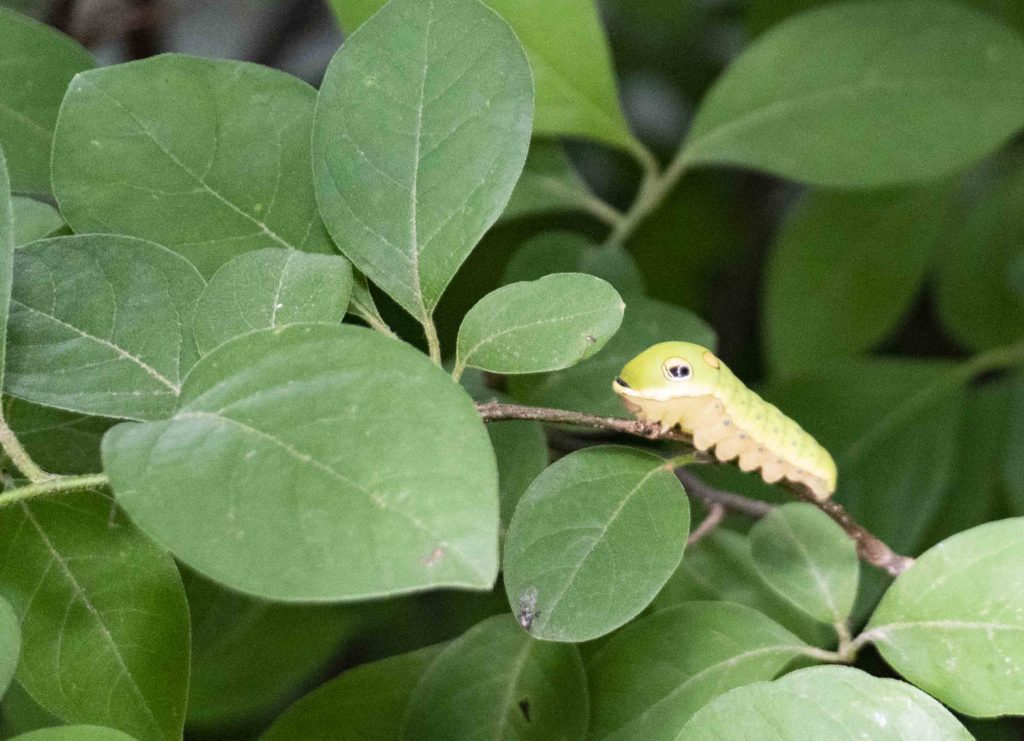
Fitting everything we want into the property requires a lot of creativity, and some compromises. Planting in layers maximizes space. I have learned that there are not many colorful flowers that grow in the shade, so our yard is monochromatic compared to our neighbors’ sunny and nearly treeless lots. Accepting that the yard is a woodland rather than a park ecosystem was an important step in stopping the cycle of wanting something to grow just because I like it, only to watch it die because it’s the wrong plant in the wrong space.
Now, we have agreed to leave a space open until we find the right shade-loving plant for the forest floor layer. Some happy residents there are wild ginger (Asarum canadense), stinging nettle (Urtica dioica), and a variety of ferns and sedges. Our newest additions are forest medicinals: black cohosh (Actaea racemosa), ginseng (Panax quinquefolius), and goldenseal (Hydrastis canadensis). Planted last fall, they are thriving under the protection of our big pin oak. It feels like we have made a new friend who feels right at home. Their habitat is the right size, has the right amount of light, and fits them with just the right amount of space.
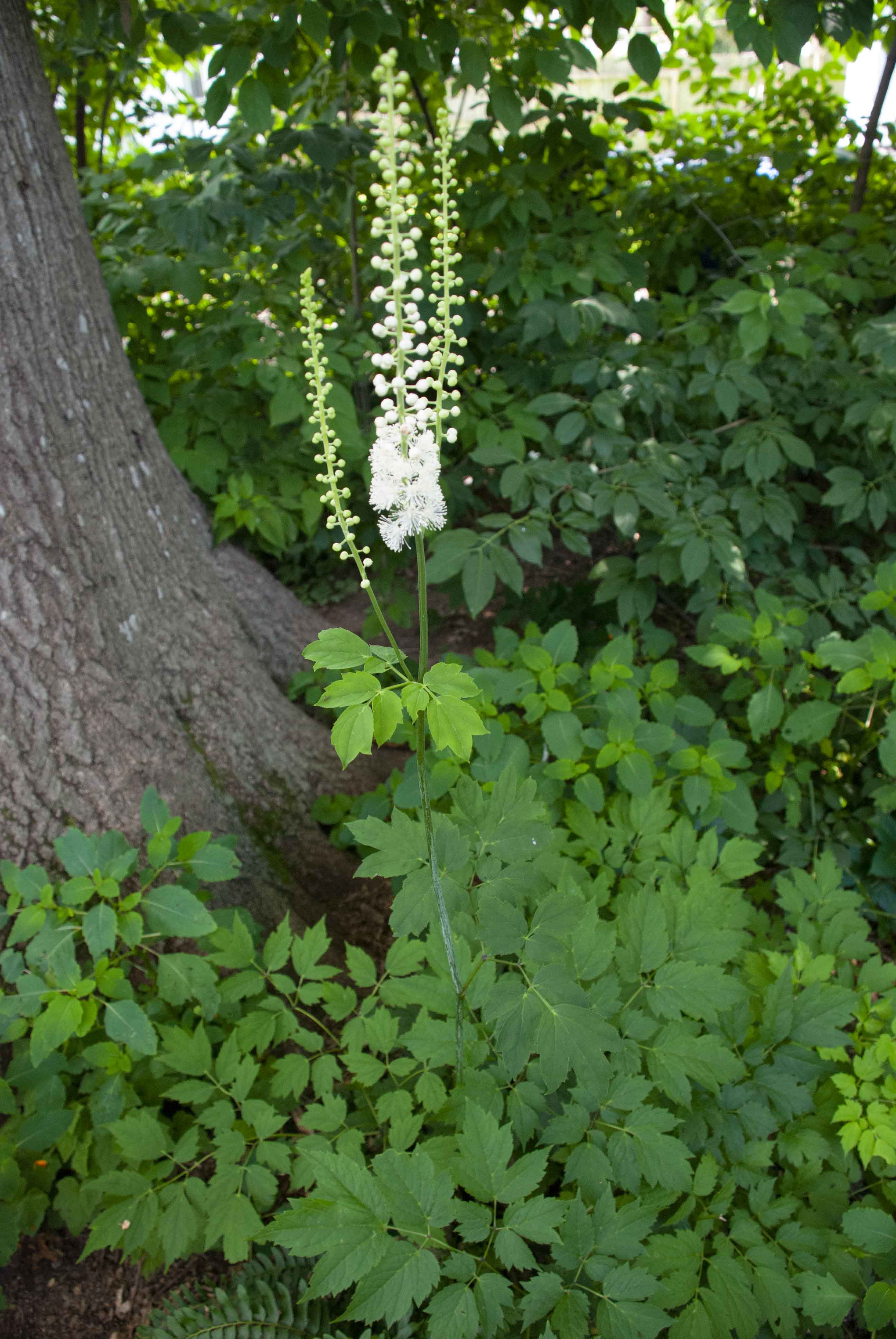
2. Food for You
Gardening for the sake of a natural landscape is not the same as gardening for the sake of feeding yourself. We’ve encouraged such a cool and shady microclimate that it has limited the space to grow annual vegetables or have a traditional kitchen garden. We got creative with one sunny patch that borders a neighbor’s fence, where a squash vine crawled up and over the fence and into the heights of the neighbor’s holly tree. It was no fun trying to harvest squash from between those prickly leaves! (https://www.hobbyfarms.com/compost-surprises-unexpected-plants-animals/)
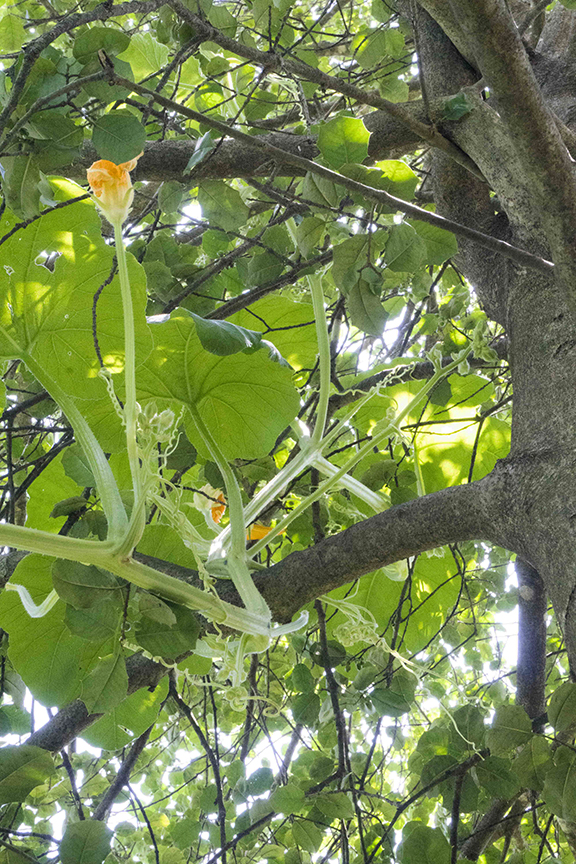
Our driveway gets the most consistent light throughout all the seasons, so we’ve slowly been adding more potted plants to the pavement and parking a little further back. We re-purposed a galvanized steel water trough as a raised bed for annual vegetables. In its first season, we enjoyed a great crop of cilantro, carrots, sweet peas and swiss chard. Ironically, pavement prevented us from planting perennials in this sunny space and is the reason we now have a container garden.
The driveway garden also uses the permaculture theory of zones. (https://www.hobbyfarms.com/farm-planning-part-two-how-can-i-feed-my-land/) The plants that need the most attention and get harvested the most often (zones 1 or 2) are closest to the center of the home (zone 0). The planted trough is the first thing I see when I pull in and park, and the last thing I see when I meander back to the house from a stroll through the forested backyard. The farther out zones are wilder but still get some attention. Brambles and hazelnuts are along our back fence (Zone 4) and wild plums are a little closer (Zone 3).
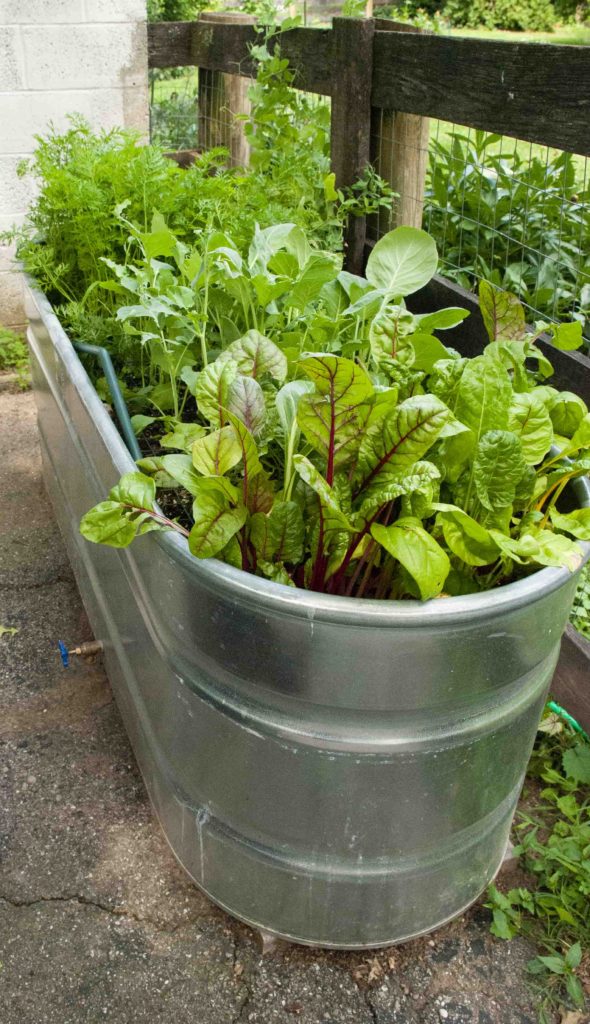
3. Food for Wildlife
Our urban oasis landscape isn’t just for us, it’s also a wildlife refuge: an escape from the lawn mowers, dogs, children, cars, really loud motorcycles and leaf blowers that surround us on all sides. Although I am aware of the problems with domestic cats going outdoors and killing wildlife, I confess that we let our three elderly cats go outside. In their later years, they were the most content when they could join us in the forest garden. Rarely did they ever catch a songbird, but they did keep the chipmunk and mouse population under control.
The cats passed away of natural causes at ripe old ages and this is our first year as empty-nesters. To fill the void of losing our best furry friends, we’ve been giving wildlife our attention. The cat food budget has transferred to wild bird seed, feeders, and wildlife-friendly plants.
To memorialize my eldest cat’s passing, I was inspired to remove a toxic ornamental plant, Taxus baccata, and replace them with some of my favorite native shrubs: button bush (Cephalanthus occidentalis), St. John’s wort (Hypericum sp.), and ninebark (Physocarpus opulifolius). (https://www.hobbyfarms.com/yew-toxic-taxus-baccata-plants/) A bird bath and feeders enhance the new planting and I am excited to see downy woodpeckers, goldfinches, cardinals, mourning doves and robins feasting. And squirrels. Lots and lots of squirrels.
Without a top predator in our local ecosystem, we have a much richer and more diverse wildlife population. The perfect symbol of this experience is an actual empty nest: a family of robins nested on our windowsill and we watched three chicks hatch and start their new lives. Witnessing wild things so close to us, safe and protected without our interference, would have never happened with three cats stalking the yard.
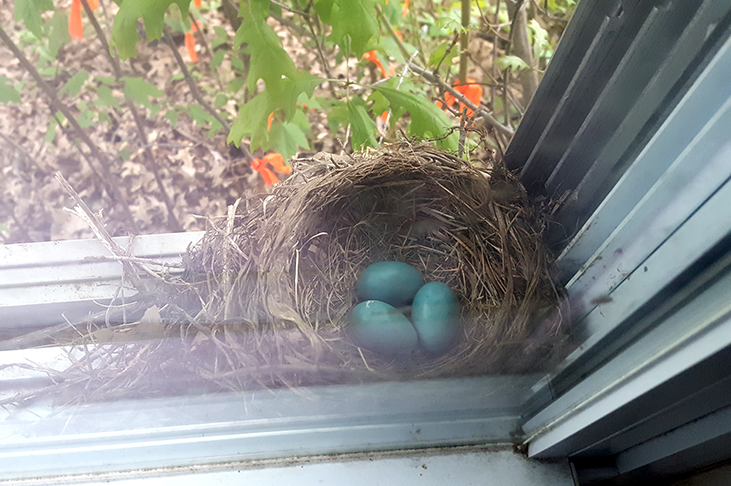
4. Finding a Balance
As I’ve written about in the book Wildlife in Your Garden, animals are in our landscapes because the conditions support them. If there’s food, water, shelter and space that suits gray squirrels, don’t be surprised when they move in. Same for chickadees, house sparrows, opossum, raccoons, groundhogs and spicebush swallowtail butterflies. We are glad they’re here, but it would also be nice if they wouldn’t eat all of the berries and nuts we’ve been hoping to enjoy ourselves. An almond tree, currants, blueberries, raspberries, blackberries, plums — all of these food forest plants we’ve selected, sited, planted, pruned, and watered. We’ve inhaled the aroma of their blossoms and said little prayers for their pollinators to find them, anticipating buds maturing into fruit and then — they disappear before they even ripen. We’ve felt torn between chasing off the blue jays or marveling at their acrobatics, as they hang upside down to pick green serviceberries (Amelanchier sp.) off spindly young shrubs outside our living room window.
Squirrels and chipmunks have their way with the potted nursery too; seeds don’t stand a chance. We’ve allowed some things to just be wildlife food. Others, we’re building protection to defend. Our sunny patch for annuals is now growing the three sisters: corn, beans and squash, along with a few sunflowers. I wrapped the garden in hardware cloth, making a 3-foot high barrier but the squirrels and birds just saw that as ornamental. Then I draped strings of CDs across and that has kept them out. The trough garden was covered in a wire grid and a light cloth until the plants got established. And, finally, Russ has begun building a greenhouse to protect his tree seedlings from squirrel destruction, and to capture the fleeting winter sun.
Somehow, I don’t really mind losing my small garden crops to wildlife. Maybe it’s because I’m still young in my serious gardening lifespan. Maybe it’s because I am not reliant on growing my own food, not yet anyway. I consume plenty, and I can afford to give up 7,000 square feet of space to nourish other beings. I’m trying to be a good neighbor with Mother Nature. By doing this, my adventurous and curious soul gets nourishment too.
Planting a food forest is a way to have the best of all landscaping worlds – shade and food, wild and domestic, ornamental and ecological. Gardening with perennials is less work, but also yields less produce than most gardeners expect, and can take years to reach maturity. Food from our forest includes shiitake mushrooms, hazelnuts, paw paws, persimmons, serviceberries, plums, blackberries, raspberries, currants, almonds, blueberries, and an array of edible, weedy herbs like violets, sorrel and dandelion. Even though they aren’t all native, they fit within the layers and niches to keep each other in check. There’s always something new to experience: a bat roosting on our back door, a magnolia blossom that we’ve been waiting months to smell, the wandering groundhog, cicadas chiming in for their summer song. Little by little we’re relinquishing our hold on the land and welcoming back Nature.

Karen Lanier is a writer and educator living in Lexington, Kentucky. She earned degrees in photography, French, and environmental documentation, along with a certificate as a professional environmental educator. She worked as a park ranger in national and state parks from California to Maine, and spent off-seasons printing photos, caring for animals, attending school, working in non-profit administration, and leading photography classes for youth. She now owns KALA Creative, which offers nature connection through writing, images, and workshops. Visit http://kalacreative.net/.
